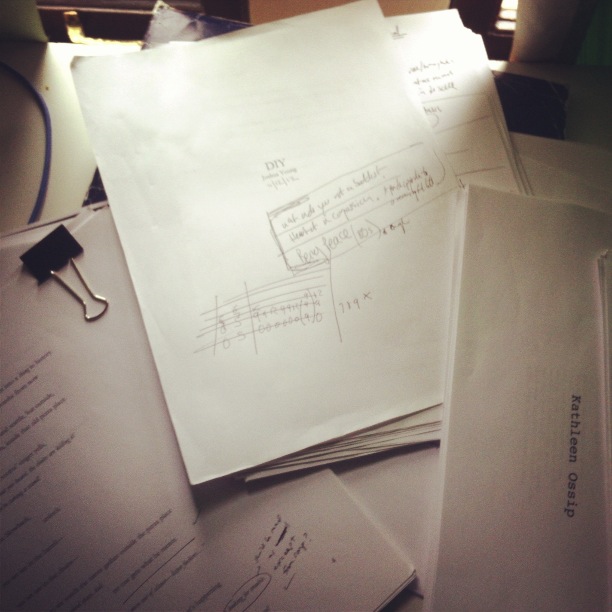
OK, Let’s Talk About My Thesis Some More
[flickr id=”8495883668″ thumbnail=”medium” overlay=”true” size=”original” group=”” align=”none”]
I’ve already met with my thesis advisor, Tony Trigilio, about my thesis twice. In our last meeting, we discussed the manuscript on the whole and how it is functioning/can function then walked through the first third of the manuscript. Because I have a manuscript that stands at 109 pages right now, Tony and I have two tasks:
1) Work on the thesis: 48-65 pages.
2) Work on the book: 100+ pages.
(….3….) Talk about where to send the book for publication and decide which individual poems to send to journals.
For the book, we’re deciding which poems are working and which are not, as well as talking about the importance of the supplemental material. Let me explain. At the end the book, I have a 20+ page section of supplemental notes, including:
• a collection of correspondences between me and my friend and Hardcore Punk expert David Woods, excerpts from the Kill Rooms tour journal. (The Kill Rooms were a Seattle Hardcore Punk band that formed in late 1981 and disbanded/disappeared somewhere between 1983 and 1984, though the story changes depending on who you talk to)
• notes from my research journal
• other random miscellany (like the list of names The Kill Rooms wrote down/discussed before landing on their name. . . and other things).
The rest of the book contains narrative, lyric, and even haiku poems, along with short prose and mini-essay-like pieces. It mirrors, in many ways, the way in which The Collected Works of Billy the Kid is organized. Well, maybe not its organization, but its ability to work as fiction, poetry, history, miscellany, photos, etc. I read this book quickly while at New Mexico State, and I don’t know if it was how I was feeling at the time or my attitude or the fact that I was focused on finishing When the Wolves Quit, but I just didn’t care about it. I rushed through it. I didn’t enjoy it. Though, when people asked, I was like, “yeah, it’s great.”
I think I knew it was great, but I didn’t want to enjoy it, and I wasn’t reading it for class, so it was just a book I was told I had to read, and so I did. But then Jenny Boully assigned it last spring, and I was like, “YES!” Even though I secretly was like, “MEH.” But, I knew that there was something in there that was important to DIY. I read it first. I read it before it was assigned to read and was appalled when people didn’t LOVE it (even though before I didn’t love it).
It changed the way I thought about DIY. Immediately, the project opened up, and something that had been dragging its feet for years suddenly took off. I had maybe 20 pages. Then by the time the semester with Jenny was over, I had 50 to 60 pages, and during the summer, I got it to 140. So, I spent the fall gutting the book. I got it down to 100 and added 9 more pages during the Thesis Development class. So, now we’re cutting this beast. For the book, we’re just cutting small pieces. It may not change in size or it may drop a few pages, but nothing serious—or that’s how it seems right now.
For the thesis, we have to cut it to 65 pages. First, we’re cutting the supplemental material. The thesis will be strictly poems and poetic-prose pieces. We’ve already cut some of the haiku and the little narrative and miscellany. So, right now it’s looking pretty good. I want the thesis to be the guts of the book. A representation of the narrative arc within. With the supplementals and miscellany, there is a self-reflexive arc that puts the research and “history” in play, alongside the narrative. And poem pieces that we’re cutting are pieces that accumulate in the book, that need the page length to do so. So, in the thesis, they seem to slow the movement down, but in the book they are needed texture.
Well, I’ll talk more about DIY as I work on it.
Later,
J
